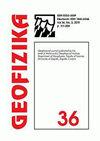利用 Facebook 的先知模型对贝尔格莱德-泽廖诺布尔道的 PM10 和 PM2.5 浓度进行短期预测
IF 1.1
4区 地球科学
Q4 GEOCHEMISTRY & GEOPHYSICS
引用次数: 0
摘要
我们在贝尔格莱德-泽廖诺布尔多监测站演示了如何使用 Facebook 的 Prophet(通常称为 "先知")模型进行短期空气质量预测。为解决数据缺失问题,我们采用了最小改变数据分布的估算技术。事实证明,线性插值法对短期缺口(1-3 小时)有效,小时均值法对中期缺口(24-26 小时)有效,Hermite 多项式插值法对长期缺口(132-148 小时)有效。最重要的数据变化是偏度变化了 3.4%。对时间序列进行分区可以对先知模型进行详细的质量评估,PM2.5 的预测比 PM10 更精确。使用最长的时间序列进行预测,PM10 的绝对误差为 6.5 微克/立方米,PM2.5 的绝对误差为 2.7 微克/立方米。根据 173 次预测,我们预计在 50% 的情况下,PM2.5 和 PM10 的先知模型均方根值将低于 6.26 μg/m3 和 9.99 μg/m3。先知模型展示了多项优势,并取得了令人满意的结果。在未来的研究中,先知模型得出的结果将作为其他模型的基准值。此外,"先知 "模型能够提供令人满意的空气质量预测结果,将在未来的研究中加以利用。本文章由计算机程序翻译,如有差异,请以英文原文为准。
Short-term forecasting of PM10 and PM2.5 concentrations with Facebook's Prophet Model at the Belgrade-Zeleno brdo
We demonstrate the use of Facebook's Prophet (usually just called Prophet) model for short-term air quality forecasting at Belgrade-Zeleno brdo monitoring station. To address missing data, we applied minimally-altering data distribution imputation techniques. Linear interpolation proved effective for short-term gaps (1–3 hours), hourly mean method for mid-term gaps (24–26 hours), and Hermite interpolation polynomial for long-term gaps (132–148 hours). The most significant data change was a 3.4% shift in skewness. Partitioning the time series enabled a detailed quality assessment of the Prophet model, with PM2.5 predictions being more precise than PM10. Using the longest time series for forecasting yielded absolute errors of 6.5 μg/m3 for PM10 and 2.7 μg/m3 for PM2.5. Based on 173 forecasts, we anticipate Prophet model root-mean-square values under 6.26 μg/m3 and 9.99 μg/m3 for PM2.5 and PM10 in 50% of cases. The Prophet model demonstrates several advantages and yields satisfactory results. In future research, the results obtained from the Prophet model will serve as benchmark values for other models. Additionally, the Prophet model is capable of providing satisfactory air quality forecasting results and will be utilized in future research.
求助全文
通过发布文献求助,成功后即可免费获取论文全文。
去求助
来源期刊

Geofizika
地学-地球化学与地球物理
CiteScore
1.60
自引率
0.00%
发文量
17
审稿时长
>12 weeks
期刊介绍:
The Geofizika journal succeeds the Papers series (Radovi), which has been published since 1923 at the Geophysical Institute in Zagreb (current the Department of Geophysics, Faculty of Science, University of Zagreb).
Geofizika publishes contributions dealing with physics of the atmosphere, the sea and the Earth''s interior.
 求助内容:
求助内容: 应助结果提醒方式:
应助结果提醒方式:


